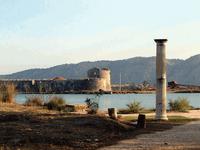You are in: Europe -> Albania -> Butrint, and traditional search or Image Gallery will yield results of this site only
Butrint
| Site number: | 570 |
|
| Type of site: | Cultural | |
| Date: | Prehistoric | |
| Date of Inscription: | 1992,1999,2007 | |
| Location: | Europe, Albania, County of Vlorë, District of Sarandë | |
Up to 75 images are shown here. Click on each for more details or on Image Gallery for more images.
Six official UN languages:
Arabic,
Chinese,
English,
French,
Russian,
Spanish
Other languages: Bulgarian, Czech, Danish, Dutch, Esperanto, Finnish, German, Greek, Hungarian, Italian, Norwegian-bokmål, Norwegian-nynorsk, Polish, Portuguese, Serbian, Slovak, Swedish
Other languages: Bulgarian, Czech, Danish, Dutch, Esperanto, Finnish, German, Greek, Hungarian, Italian, Norwegian-bokmål, Norwegian-nynorsk, Polish, Portuguese, Serbian, Slovak, Swedish
| Description: | Butrint has identified as a Greek colony, a Roman city and a bishopic-functioning as a dwelling since prehistoric times. The city was prosperous under the Byzantine administration, followed by a brief occupation by the Venetians. However Butrint was abandoned after marshes formed in the area in the late Middle-Ages. Each period of the city's development is represented in the current archaeological site in its collection of ruins. --WHMNet paraphrase from the description at WHC Site, where additional information is available. | |
| Butrint (Albanian: Butrint or Butrinti) is an ancient city and an archeological site in Albania, close to the Greek border. It was known in antiquity as Βουθρωτόν Bouthroton in Ancient Greek and Buthrotum in Latin. It is located on a hill overlooking the Vivari Channel. Inhabited since prehistoric times, Butrint has been the site of an Epirot city, a Roman colony and a bishopric. Butrint was originally a town within the ancient region of Epirus. It was the one of the major centres of the local Chaonian tribe with close contacts to the Corinthian colony on Corfu and Illyrian tribes to the north. According to the Roman writer Virgil, its legendary founder was the Trojan seer Helenus, the son of King Priam, who had married Andromache and moved West after the fall of Troy. The Greek historian Dionysius of Halicarnassus as the Latin poet Virgil wrote that Aeneas visited Butrint after his own escape from the destruction of Troy.First archaeological evidence of sedentary occupation dates to between 10th and 8th centuries BC. The original settlement probably sold food to Corfu and had a fort and sanctuary. Butrint was in a strategically important position due its access to the Straits of Corfu. By the 4th century BC it had grown in importance and included a theatre, a sanctuary to Asclepius and an agora. --Wikipedia. Text is available under the Creative Commons Attribution-ShareAlike License. | ||
| Source: | http://whc.unesco.org/en/list/570 | |
| Reference: | 1. UNESCO World Heritage Center, Site Page. | |
































